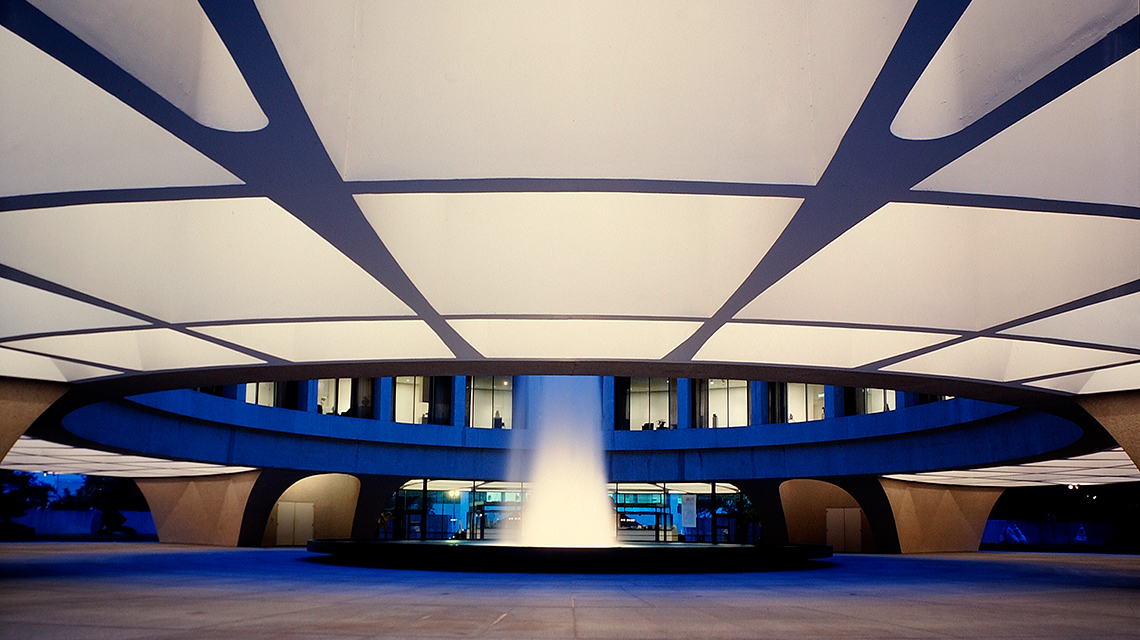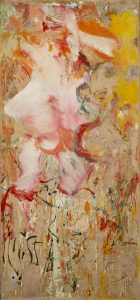Analysis of Willem de Kooning’s Woman, Sag Harbor, 1964 and Woman, 1965

 Between 1964 and 1966, de Kooning painted a series of larger-than-life female images on hollow-core doors, two of them Woman, Sag Harbor (1964; fig 1) and Woman 1965 (fig. 2). These works, considered a benchmark in the artist’s career, confirm a shift in his technical methods that had begun around 1960. Using support primed with smooth, opaque what grounds, pigments mixed with large amounts of white, and an increasingly fluid paint medium, he exploited the potentials of his materials to create paintings evocative of the water-surrounded environment of Long Island’s East End.
Between 1964 and 1966, de Kooning painted a series of larger-than-life female images on hollow-core doors, two of them Woman, Sag Harbor (1964; fig 1) and Woman 1965 (fig. 2). These works, considered a benchmark in the artist’s career, confirm a shift in his technical methods that had begun around 1960. Using support primed with smooth, opaque what grounds, pigments mixed with large amounts of white, and an increasingly fluid paint medium, he exploited the potentials of his materials to create paintings evocative of the water-surrounded environment of Long Island’s East End.
Woman, Sag Harbor was the first of the so-called door paintings, which according to John McMahon, de Kooning’s studio assistant at the time, ensued when de Kooning began painting on doors discarded during the construction of the studio he was building for himself in Springs.1 McMahon remembers the artist’s elaborate specifications for the grounds of these paintings, involving up to six layers of white oil paint, with each application sanded to a smooth finish before the next one was laid over it.2 The grounds of Woman, Sag Harbor and Woman, though, are in fact rather thin, indicating that de Kooning was continuing his lifelong practice of repeatedly scraping and sanding down his painting and abrading the ground layers in the process.
As he had done before, de Kooning created his imagery through a series of complex maneuvers that included tracing, superimposing and combining drawings and transfers of one painting, or fragments of it, to the surface of another, often through the use of a reverse image of it made by pressing paper against its still-wet paint. A comparison of the drawn elements of Woman, Sag Harbor with those in Woman (1964; fig 3, Hirshhorn Museum), for example, reveals that the women’s feet and shoes are near mirror images of each other, indicating that Woman is probably a transfer from an early state of Woman, Sag Harbor.
Photographs and anecdotal references suggest that by the time de Kooning painted Woman, Sag Harbor, he had discontinued his use of both house paints and the poppy-seed oil he had employed as an additive in the period of Untitled (May 1962, Hirshhorn Museum), and instead was adding safflower cooking oil to artist’s oil paints.3 To a visitor to his studio in 1964, he bragged that he had found a salad oil that he could use in lieu of expensive artist’s oils, and a photograph of him in his studio by Dan Budnik, from 1971, shows a bottle of Saff-o-life safflower oil on his work table (fig. 4).4 In 1978, he told an interviewer that he used safflower oil because it “stays wet a long time, it doesn’t dry like linseed oil, I can work longer.”5
At the time of Woman, Sag Harbor, de Kooning was preparing his paint mixtures from Bellini artists’ tube colors according to recipes that he had developed.6 Once he had thoroughly combined a number of his tube paints on a glass palette, he would scoop the blended paints into a bowl and then add safflower cooking oil, water, and kerosene or some other solvent, whipping the ingredients with a brush to a fluffy consistency. He did not add the safflower oil and water according to a set formula but rather worked by feel, blending until the paint reached the consistency he desired. Medium analysis corroborates this report: seven paint samples from Woman, Sag Harbor correlate with naturally aged samples of safflower oil mixed with artists’ tube paint. This is also true of several samples taken from works painted later in the 1960s, including Woman (1965), The Visit (1966–67; Tate, London), and Two Figures in a Landscape (1967; Stedelijk Museum, Amsterdam).7
This unorthodox medium gave de Kooning a way to apply abundant amounts of paint that he then could rework over a long time—an advance on one of his long-established practices. His use of a slower-drying paint meant that now, more easily than ever before, he could scrape down the entire surface of the picture, or parts of it, leaving no more than traces of charcoal lines and faint paint residues of former images. As a result, unlike many of his earlier works, Woman, Sag Harbor , Woman, 1965, and works like them record only the last stage in a process that involved many stages of painting, scraping, and repainting.
The increased liquidity and slipperiness of de Kooning’s binding medium, and his use of a smooth support, allowed him to move his brush more quickly across the face of the painting. While quick brushstrokes are certainly also characteristic of his earlier works, the greater speed with which he applied the more fluid paint of the door series is sensible to the eye following the rapid movement of the brush where it hit the panel, skidding, twisting, and often abruptly turning when it was lifted. De Kooning’s friend Joan Ward remembers experimenting with de Kooning’s medium and found it so slippery that she “could not keep the brush on the canvas.”8 De Kooning’s slower-drying, medium-rich paints facilitated brushwork more complex and varied than earlier in his career; the paintings of this period are panoplies of textures and colors worked wet-into-wet, with later brushstrokes dragging and blending with earlier ones. In Woman, Sag Harbor, the figure’s torso is outlined with fluid yellow paint that de Kooning brushed through still-wet areas of pink, red, green, and blue. As he worked, he dragged in the adjacent colors, blending them on the surface (fig. 5).
In addition to the complex paint textures that de Kooning produced with his brush, the surfaces of Woman, Sag Harbor, Woman, and many works of the 1960s and ’70s have developed peculiar depressions and wrinkles upon drying. Circular, craterlike formations in the paint surfaces of many pictures of this period were formed as water and air bubbles, resulting from the temporary emulsion of water and oil, popped or collapsed once the paint was applied (fig 6) Likewise, the wrinkling or “shriveling” evident in many areas of Woman, Sag Harbor probably results from the addition of water and excess oil to the paint.
Color plays a significant expressive role in the door paintings. When de Kooning moved to East Hampton, he was moved by the light and color of his new location and selected a range of hues that better reflected the out-or-doors, telling Harold Rosenberg that he began to make his own colors in order to incorporate the feeling of the natural light literally in his painting: “When I came here I made the color of sand and mixed it. And the grey-green grass, the beach grass, and the ocean was all kind of steely grey most of the time…. Indescribable tones, almost. I started working with them and insisted that they would give me the kind of light I wanted.”9
Identification of the pigments in Woman, Sag Harbor and Woman, 1965, reveals that de Kooning’s paints are not elaborate mixtures but a rather restricted palette of single colors and their pastels, most of them modern pigments available only since earlier in the twentieth century.
Remarks that de Kooning made in 1964, the year of Woman, Sag Harbor, suggest he was continuing to search for a way to convey the very substance of his new environment, and that the images of this period relate in some way to the water-surrounded environment of the East End: “Now I go on my bicycle down to the beach and search for a new image of the landscape. And I love the puddles. When I see a puddle, I stare into it. Later, I don’t paint a puddle, but the image it calls up within me. All the images inside are from nature anyway.”10
1 John McMahon, personal communication with the author, October 18-21 1993. See also Judith Zilczer, Willem de Kooning from the Hirshhorn Museum Collection, Washington, D.C., 1993: 161 n. 14.
2 McMahon, personal communication with the author. The pigment composition of the ground is approximately equal parts titanium dioxide and zinc oxide with small amounts of kaolin.
3 On de Kooning’s use of poppy-seed oil, see Susan Lake, Willem de Kooning: The Artist’s Materials, Los Angeles, 2010. No house paints have been identified in any of the paintings executed after 1963. Although McMahon, in ibid., recalls that many cans of house paint were moved from the New York studio to Long Island when de Kooning moved to Springs, in 1963, he does not remember ever seeing de Kooning use them.
4. De Kooning said of the safflower oil, “It only costs 79 cents a bottle.” In George Dickerson, Transcript of an Interview with Willem de Kooning, September 3, 1964: 6. On file with the Thomas B Hess Papers, Archives of American Art, Smithsonian Institution, Washington, D.C., 1964:6. Thomas Hess was the first of de Kooning’s contemporaries to publish the artist’s addition of safflower oil to his paints; see Hess, De Kooning: Recent Paintings, New York, 1967 1967:32.
5 De Kooning, in Gaby Rodgers, “Willem de Kooning: The Artist at 74,” LI: Newsday’s Magazine for Long Island (May 21, 1978): 21.
6. McMahon, personal communication with the author. De Kooning recorded the ingredients of the mixtures on a handmade chart that can be seen hanging on the wall to the left of the easel in photographs of the artist’s studio. At some later date, probably in the early 1980s, he switched from Bellini to Winsor and Newton paints.
7 See Lake and Michael Schilling in Lake 2010:72–86.
8 Joan Ward, quoted in Richard Shiff, “Water and Lipstick: de Kooning in Transition,” in David Sylvester, Richard Shiff, and Marla Prather, Willem de Kooning: Paintings, Washington, D.C., 1994:65 n. 20.
9 De Kooning, in Harold Rosenberg, “Interview with Willem de Kooning,” ARTnews 71 (September 1972): 58.
01 De Kooning, in Dickerson 1964:16.